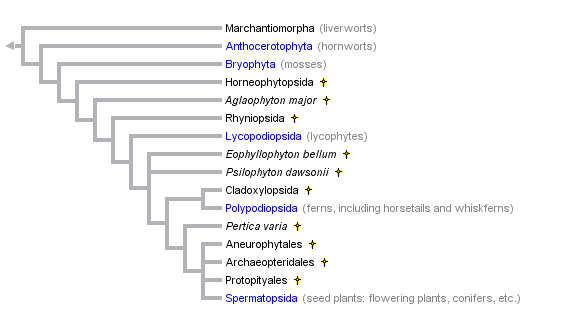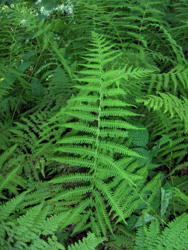Embryophytes
Land Plants
Paul Kenrick and Peter Crane


This tree diagram shows the relationships between several groups of organisms.
The root of the current tree connects the organisms featured in this tree to their containing group and the rest of the Tree of Life. The basal branching point in the tree represents the ancestor of the other groups in the tree. This ancestor diversified over time into several descendent subgroups, which are represented as internal nodes and terminal taxa to the right.

You can click on the root to travel down the Tree of Life all the way to the root of all Life, and you can click on the names of descendent subgroups to travel up the Tree of Life all the way to individual species.
For more information on ToL tree formatting, please see Interpreting the Tree or Classification. To learn more about phylogenetic trees, please visit our Phylogenetic Biology pages.
close boxReferences
Donoghue, M. J. 1994. Progress and prospects in reconstructing plant phylogeny. Annals of the Missouri Botanical Garden 81:405-418.
Doyle, J. A. 1998. Phylogeny of vascular plants. Annual Review of Ecology and Systematics 29:567-599.
Duff, R. J. and D. L. Nickrent. 1999. Phylogenetic relationships of land plants using mitochondrial small-subunit rDNA sequences. American Journal of Botany 86:372-386.
Judd, W. S., C. S. Campbell, E. A. Kellogg, P. F. Stevens, and M. J. Donoghue. 2002. Plant Systematics: A Phylogenetic Approach. Second Edition. Sinauer Associates, Inc., Sunderland, MA.
Kenrick, P. and P. R. Crane. 1997. The origin and early evolution of plants on land. Nature 389:33-39.
Kranz, H. D. and V. A. R. Huss. 1996. Molecular evolution of pteridophytes and their relationship to seed plants: Evidence from complete 18S rRNA gene sequences. Plant Systematics and Evolution 202:1-11.
Nickrent, D. L., C. L. Parkinson, J. D. Palmer, and R. J. Duff. 2000. Multigene phylogeny of land plants with special reference to bryophytes and the earliest land plants. Molecular Biology and Evolution 17:1885-1895.
Pryer, K. M., H. Schneider, A. R. Smith, R. Cranfill, P. G. Wolf, J. S. Hunt, and S. D. Sipes. 2001. Horsetails and ferns are a monophyletic group and the closest living relatives to seed plants. Nature 409:618-622.
Qiu, Y. L., Y. R. Cho, J. C. Cox, and J. D. Palmer. 1998. The gain of three mitochondrial introns identifies liverworts as the earliest land plants. Nature 394:671-674.
Renzaglia, K. S., R. J. Duff, D. L. Nickrent, and D. J. Garbary. 2000. Vegetative and reproductive innovations of early land plants: implications for a unified phylogeny. Philosophical Transactions of the Royal Society of London Series B 355:769-793.
Rothwell, G. W. 1999. Fossils and ferns in the resolution of land plant phylogeny. Botanical Review 65:188-218.
Soltis, P. S., D. E. Soltis, V. Savolainen, P. R. Crane, and T. G. Barraclough. 2002. Rate heterogeneity among lineages of tracheophytes: Integration of molecular and fossil data and evidence for molecular living fossils. Proceedings of the National Academy of Sciences (USA) 99:4430-4435.
Soltis, P. S., D. E. Soltis, P. G. Wolf, D. L. Nickrent, S.-M. Chaw, and R. L. Chapman. 1999. The phylogeny of land plants inferred from 18S rDNA sequences: Pushing the limits of rDNA signal? Molecular Biology and Evolution 16:1774-1784.
Information on the Internet
- Internet directory for Botany: Vascular Plant Families
- Land Plants Online. Dan Nickrent and Karen Renzaglia, Southern Illinois University at Carbondale.
- Vascular Plant Families and Genera. Compiled by R. K. Brummitt and published by the Royal Botanic Gardens, Kew in 1992.
- Kew Record of Taxonomic Literature. A database of references relevant to the taxonomy of flowering plants, gymnosperms and ferns.
- Index Nominum Supragenericorum Plantarum Vascularium. University of Maryland.
- Vascular Plant Family Nomenclature. James L. Reveal, University of Maryland.
- Germplasm Resources Information Network (GRIN)
Taxonomy. National Germplasm Resources Laboratory, Beltsville, Maryland.
- Vascular Plant Image Gallery. Texas A&M University. Bioinformatics Working Group.
- Albion College Vascular Plant Image Gallery
- Flora of North America
- A Synonymized Checklist of the Vascular Flora of the United States, Puerto Rico, and the Virgin Islands.
- Flora Mesoamericana
- Atlas Florae Europaeae
- Flora of China
- Biflora database of plants. A scientific database with information about the highly endangered plant species of the island of Hainan, P.R. China.
- Conspectus of the Vascular Plants of Madagascar. Missouri Botanical Garden.
- Flora of the Hawaiian Islands. Smithsonian Institution.
- Calflora. Information on California plants for conservation, research, and education.
- Southeastern Rare Plant Information Network (SERPIN).
- Digital Flora of Texas
- Atlas of Florida Vascular Plants
- Wisconsin Vascular Plants
- Atlas of the Vascular Plants of Utah
- Atlas of the Vascular Plants of Wyoming
- Checklist of Online Vegetation and Plant Distribution Maps. Compiled by Claire Englander and Philip Hoehn.
- Plant Fossil Record database (PFR). International Organisation of Palaeobotany (IOP).
- Links for Palaeobotanists
- The Rhynie Chert and its Flora. Forschungsstelle für Paläobotanik, Westfälische Wilhelms-Universität Münster.
Title Illustrations

| Scientific Name | Plagiomnium ellipticum |
|---|---|
| Location | Thunder Bay, Ontario, Canada |
| Specimen Condition | Live Specimen |
| Source | Plagiomnium ellipticum |
| Source Collection | Flickr |
| Image Use |
 This media file is licensed under the Creative Commons Attribution-NonCommercial-ShareAlike License - Version 2.0. This media file is licensed under the Creative Commons Attribution-NonCommercial-ShareAlike License - Version 2.0.
|
| Copyright | © 2003 cmoray1 |
| Scientific Name | Rosa canina |
|---|---|
| Location | Reed's Beach, Cape May County, New Jersey, USA |
| Specimen Condition | Live Specimen |
| Source | Dog Rose, P6070047 |
| Source Collection | Flickr |
| Image Use |
 This media file is licensed under the Creative Commons Attribution-NonCommercial License - Version 2.0. This media file is licensed under the Creative Commons Attribution-NonCommercial License - Version 2.0.
|
| Copyright | © 2005 Anita Gould |
| Scientific Name | Thelypteris palustris |
|---|---|
| Specimen Condition | Live Specimen |
| Source | Marsh-Fern |
| Source Collection | Flickr |
| Image Use |
 This media file is licensed under the Creative Commons Attribution License - Version 2.0. This media file is licensed under the Creative Commons Attribution License - Version 2.0.
|
| Copyright | © 2008 homeredwardprice |
About This Page
Paul Kenrick

The Natural History Museum London, United Kingdom
Page copyright © 1996 Paul Kenrick and
All Rights Reserved.
Citing this page:
Kenrick, Paul and Peter Crane. 1996. Embryophytes. Land Plants. Version 01 January 1996 (temporary). http://tolweb.org/Embryophytes/20582/1996.01.01 in The Tree of Life Web Project, http://tolweb.org/











 Go to quick links
Go to quick search
Go to navigation for this section of the ToL site
Go to detailed links for the ToL site
Go to quick links
Go to quick search
Go to navigation for this section of the ToL site
Go to detailed links for the ToL site